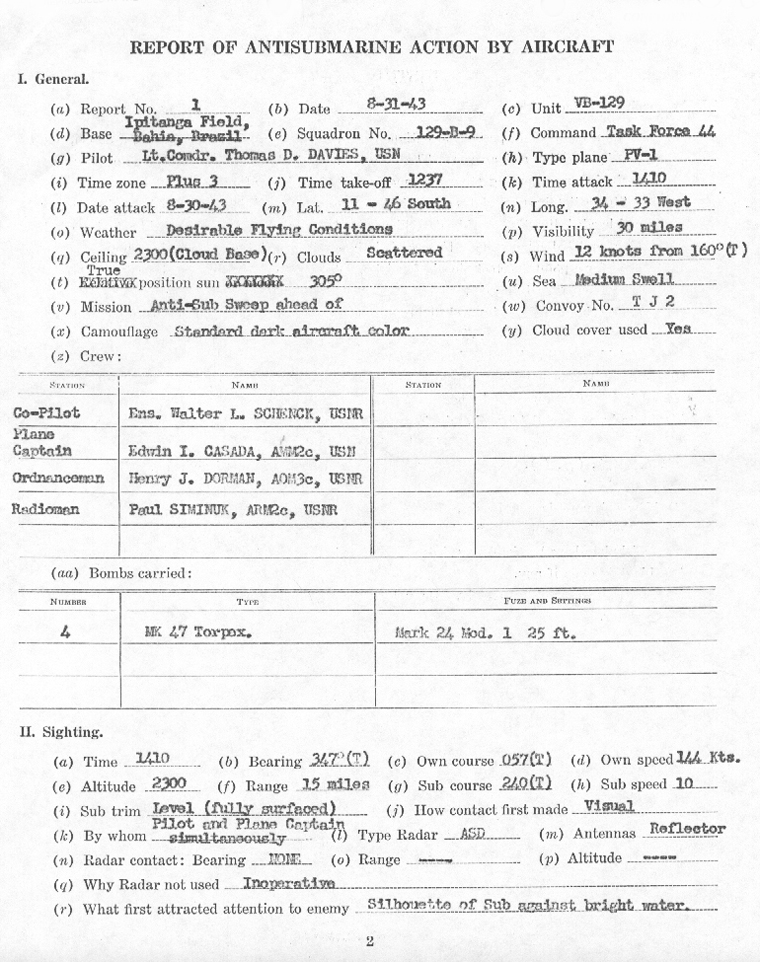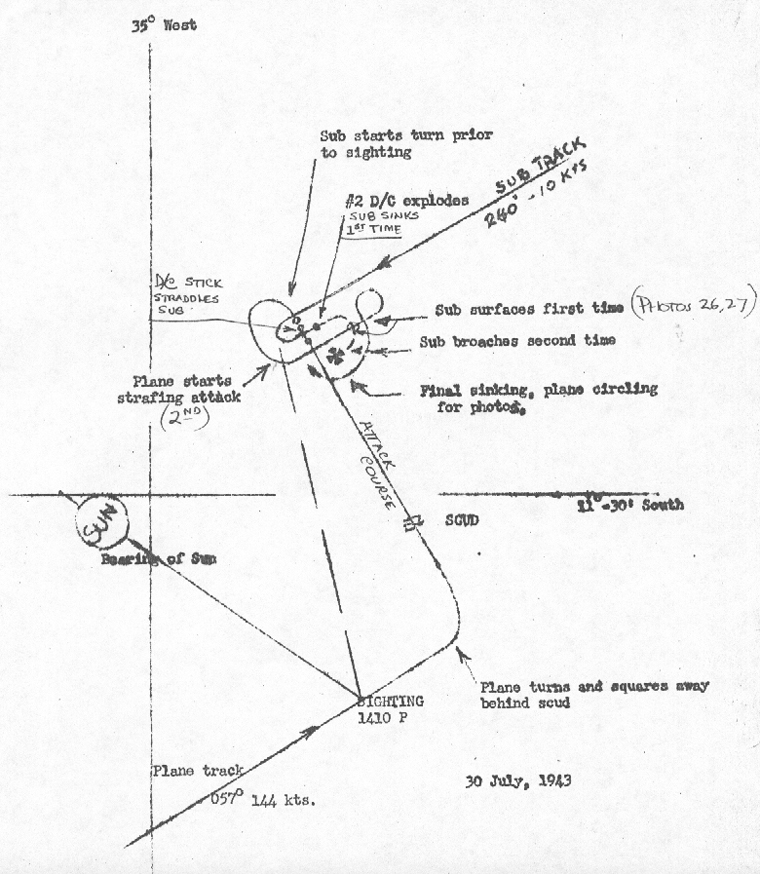
UNITED STATES ATLANTIC FLEET |
||
AIR FORCE |
||
BOMBING SQUADRON 129 |
||
"A" |
||
| APPROACH AND ATTACK | ||
| When sub was sighted it had started a turn toward plane to minimize its silhouette. Upon seeing that plane had sighted it, completed 1800 turn - putting beam to plane and unmasking battery. Pilot utilized small piece of scud about 5 miles distant in the direction of sub at 1200 feet for cloud cover. Plane was rolled over behind this and squared away for attack, going through the scud at 265 knots. As soon as plane was within approximately 4 miles sub opened fire. When under one mile plane fired sighting burst and then put sub under heavy .50 cal. fire. Shortly thereafter sub stopped firing and plane passed over slightly forward of conning tower at about 50 feet. (Sub guns were observed to be abandoned at this point) Drop was made, No. 1 exploding about 50 feet short, No. 2 apparently hitting sub and not exploding, No. 3 about 110 feet over and No. 4 about 195 feet over. Sub slowed but continued to move until after it had gone about 300 yards when No. 2 bomb apparently was dislodged and a violent under water explosion was observed midway between conning tower and stern throwing water about 200 feet in air. Sub sank slowly, level, and continued slowly ahead. Emission of three large air bubbles accompanied by oil (photos 4, 5, and 7) indicated the sub to be still in motion and changing course 900 to the right. The sub then broached bow first, conning tower awash. (See photo 26) While in this condition plane made another strafing attack (photo 27 at termination of attack) and sub continued to change course slowly to the right and lose way. Sub then sank slowly stern first. (Photo28) Three more large air bubbles (photos 32 and 33) were emitted showing sub still moving very slowly and on a course the reverse of its original. Stern then broached, conning tower never quite coming out. (See photo 35) Sub stopped as stern came out at a higher angle exposing rudder and screws. (See photo 43) Stern continued to elevate, screws stopped and submarine became dead in water. (See photos 45, 46 and 47) Sub remained in this condition for approximately 3 minutes and then slowly slid down out of site, leaving oil slick and a stationary air boil which persisted for about 15 minutes. | ||
| No further evidence of sub was seen although plane remained in vicinity for 2 hours and 20 minutes. No survivors were observed from plane, however photo No. 45 shows small disturbance lower center which has not been accounted for. During the entire engagement 4 sharks were seen in the immediate vicinity. Photo 27 enlarged shows a cartoon type sawfish on conning tower which was painted in yellow and green and which may enable identification of submarine. | ||
UNITED STATES ATLANTIC FLEET |
||
AIR FORCE |
||
BOMBING SQUADRON 129 |
||
"B" |
||
| COMMENT OF SQUADRON COMMANDER: | ||
| It is considered that this was a well planned and executed attack. Conditions of sighting indicate that this crew was alert. | ||
| It is regretted that none of the three other planes of this command which were conducting the sweep which resulted in this sighting were able to close to the area of contact due to fuel limitations. Four planes, 1 PV, 1 PBM and 2 A28 (Brazilian Air Force) were despatched to the scene and patrolled the area using bating tactics until 1830 P, one hour after darkness when bad weather prevented further search. No contacts were made by these planes. | ||
| In order to obtain a lower plane loading enabling this squadron to operate from short runway--restricted approach fields prevalent in the area of present operations, the bomb load of this squadron has been reduced to four bombs. In view of this reduction, the stick spacing has been increased to 75 feet. As the bombing error of the pilots is reduced by further and continued training this spacing will be shortened to 60 feet as prescribed by Cominch doctrine. | ||
| This attack has made apparent the urgent necessity for more intense training of crew members of this squadron in aerial photography. It is believed that the addition of a 16mm magazine load, turret head type movie camera, complete with wide angle and telephoto lens, to the photographic equipment of each A/S plane would greatly improve the quality and quantity of A/S pictures. | ||
| The communication difficulties encountered have been greatly rectified by the addition of two frequencies. | ||
| In view of the location of the violent explosion which occurred midway between conning tower and stern, the subsequent very erratic actions of the submarine, it is believed that this submarine was sunk. | ||
| JAMIE E. JONES, | ||
| Lieut.Comdr., USN. | ||
